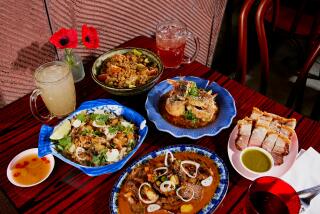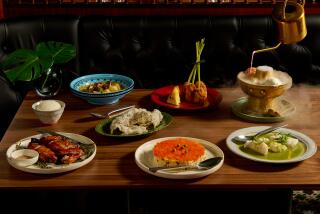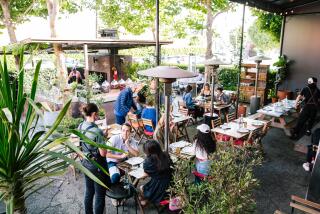TRAVELING in style : A CERTAIN GENTLENESS : Bangkok’s Oriental has all the luxe of any grand hotel, but it is appreciated most for the warm, human quality of its Thai staff.
At the time the Oriental Hotel in Bangkok was preparing for a visit by Princess Grace of Monaco, a great effort was made to ensure that such an important guest be addressed by her correct title. Then-resident manager Gregory Meadows rehearsed the staff: “Remember, the princess must always be called ‘Your Serene Highness.’ ”
A luncheon in the princess’ suite was the first test. The room-service manager was put in charge of every detail. After the last trolley had been wheeled into the palatial apartment and the royal guests had been left to enjoy their meal in privacy, Meadows asked the servers whether all had gone well. Yes, said the head of room service, everything was perfect.
“And how did you address the lady?” Meadows asked. The reply came with a typically wide and innocent Thai smile: “Oh, we remembered, sir. We all addressed her several times as ‘Your Royal Serenade.’ ”
The Oriental, perennially judged one of the great hotels of the world, does not often fail in the execution of important details. “But we are human,” said Meadows, “and I suppose that’s one of our assets, too.”
It is. Like any hotel, the Oriental can be measured by the ambience of its lobby, the size and decor of its rooms or even the credentials of its chef de cuisine ; but this hotel is more often appreciated, it seems, for the warm, human quality of its staff of gentle Thais.
(There can be exceptions. A celebrity guest once became impatient with the hotel telephone operator. The guest asked three times to be connected with the hotel press officer. Each time she got the laundry.)
The Oriental is luxurious and even romantic in its historic river-side setting; it is a movable feast and a paragon of good hotel management. Beyond those great and commendable factors, however, I agree that it is the compliant and loyal staffers who make this hotel a special place. Only 5% to 7% of the staff are replaced annually, and few ever defect to other hotels.
(“Can I help you, sir?” asked the young housekeeper who was busy guiding a big polishing machine across the lobby floor. I had been looking around helplessly to find the mail drop; it wasn’t that lad’s job to help a guest, but he saw that I needed assistance, so he volunteered. “Of course he would,” Meadows said. “No one on the Oriental staff ever says: ‘It’s not my job.’ ”)
The hotel has been a landmark on the banks of Bangkok’s busy, silty Chao Phraya, the River of Kings, for 113 years. It was opened in 1876, then rebuilt as the “new” Oriental in 1886 by a Danish merchant captain, Hans Niels Andersen. The headquarters of Andersen’s East Asiatic Co.--a massive, old colonial-style building--still stands next to the hotel property. The hotel that Andersen built was a two-story quadrangle with an open courtyard at the center. It advertised “comfortable quarters for gentlemen of the sea.” Old photographs show that the front of the building, a space shaded by large trees, was only about 25 yards from the river’s edge. This same building, with the original “Oriental Hotel” lettering above the door, survives as a treasured part of today’s Oriental.
Over the years, the hotel has grown in several dimensions, all within its original enclave of prime river-front property. A three-story, wood-frame-construction “river wing” was added in the ‘20s (and subsequently demolished). In 1958, a modern “tower block” was grafted onto the back of the 1886 hotel. Finally, in 1976, a $15-million, 16-story “river wing” was opened; 350 of the hotel’s 406 rooms and suites are in the new tower.
In addition to offering the gracious qualities that more than 1,000 Thai employees bring to the Oriental (staff-to-guest ratio runs about 2.2 to 1), the hotel has become a special place in Bangkok. Until recent years, it had been entirely unrivaled as the best and most famous hotel in town. As a result, anyone who traveled in style to this exotic capital of old Siam came automatically to the Oriental. While in earlier eras, London or Paris had a dozen first-rank hotels from which the discriminating might choose, Bangkok had but one; as a consequence, its reputation grew worldwide. Today, despite competition from some new luxury hotels, the Oriental’s world-class standing and enviable occupancy rate (typically above 90%) are unlikely to be eclipsed.
Inevitably, among the hotel’s guests during its years of absolute primacy in Bangkok were a number of famous authors, including Joseph Conrad, Somerset Maugham and Noel Coward. (In 1888, Conrad--on his first visit to Bangkok--wrote: “In the light of the crimson sunset, all ablaze behind the golden pagodas, I made my way to the Oriental.”)
It was probably not anticipated at the time, but the names of the major literary figures on the hotel’s guest list would cast a long shadow. Today, the Oriental has appropriated the aura of their names and of their times. The original 1886 building, now called the Authors’ Residence, has been converted into four exclusive, elaborately decorated suites named for Conrad, Maugham, Coward and James Michener. Whether any of the gentlemen actually occupied the apartments is not known, but on end tables or antique breakfronts, one will find their photographs in small silver frames, and some first editions of their books are casually placed on the writing desks. It is very much as though the novelist himself were still in residence and had just stepped out to take a stroll along the river.
Author’s suites, incidentally, costfrom $423 to $538 a day--or one may reserve the entire Authors’ Residence, including four servant’s rooms, for about $2,650 a day (plus 10% service charge and 11% tax). Even one of Conrad’s most memorable characters is evoked in the name given to the Oriental’s handsome seafood restaurant, Lord Jim’s. The decor, all blue and white with polished teak and burnished brass, is a replica of the afterdeck of an Edwardian yacht.
The sense of being a part of a period--perhaps of history itself--is an element in each guest’s experience. Old photographs documenting the hotel’s development--from a homey, colonial-style establishment with ceiling fans to its present state of luxury--decorate some of the corridors and public areas. If there seems a conceit in all this, no one complains. Indeed, one nostalgic guest asked to have the air conditioning in his room disconnected and mosquito netting rigged above his bed so that he might recreate the particular environment he remembered at the Oriental before World War II.
Idiosyncratic requests are a part of every great hotel’s lore. The Oriental has had its share. (“Can you be a dear and arrange a Thai-style wedding for us by 4 o’clock?”) Day in, day out, however, the Oriental--a Mandarin International Hotel since 1967--is primarily in the business of satisfying the demands of the world-class travelers and businessmen who occupy its 22 suites and 384 rooms.
Like many luxury-class hotels, the Oriental keeps carefully compiled history cards on thousands of its regular visitors. An international banker who lets the hotel know that he likes his beer at room temperature will not find it stashed in his mini-bar refrigerator the next time he is a guest. Likewise, those who prefer firm pillows will get them without having to ask a second time.
Although the Oriental is centrally located in a swirling, smoggy, traffic-choked metropolis of more than 5 million, it does not give the feeling of being a big-city facility or a traveling man’s hotel. Indeed, one of the charms of this historic establishment is that once one enters its rambling precincts, Bangkok seems far away--replaced by a relaxed, resort-hotel environment. The sparkling pool, surrounded by tropical plantings, is just beyond the lobby; guests in robes or cover-ups sometimes scurry through, leaving wet footprints on marble floors. Just across the river (via the hotel ferry) is a new, three-acre sports-and-fitness center with facilities for squash, night-lighted tennis courts, a jogging track and a sauna.
The central court of the 1886 Authors’ Residence has been roofed with translucent fiberglass; it is now an all-weather solarium where jungle-size clumps of living bamboo stand two stories tall in each corner, and where white cane furniture with parasols provides a summery informality. Afternoon tea and cocktails are served here.
The Oriental’s main lobby is more elegant, yet not formal. (Youthful-appearing doormen in white gloves and traditional Thai jongkrabane “pants” are forever on duty.) Great, bell-like chandeliers are suspended overhead; large, intricately carved golden ornaments hang from the mouth of each. Sunlight dappling through greenery enters the room via a floor-to-ceiling window wall. A small marble fountain, topped with a cascade of orchids, makes a pleasantly distracting splash of sound and color. Each afternoon, a string quartet--three men and a woman dressed all in white--plays light classical selections.
One outdoor area that sets the Oriental apart from most city hotels is a broad terrace that ranges along the entire river front, from the gardens of the original hotel, past the pool area and on to the new River Wing. Barbecue dinners are served on this lido every night; four busy chefs in white toques make clouds of appetizing smoke as they grill lobsters, beef, squid and satay (kebab). Families bring children for informal dining; musicians stroll, and the dark, silent shapes of rice barges slide by.
(In 1922, when Maugham was living at the Oriental, he wrote of the same place: “Large steamers and sailing vessels came up the river so that it had quite the air of a busy port; and if you have a passion for travel, it is impossible to look at the smallest, shabbiest, seagoing tramp without a thrill of emotion. . . .”)
At the other end of the river terrace, near the pool, the newly remodeled Verandah restaurant offers a morning-to-midnight service of everything from snacks to steaks, both indoors and out. That is where I stopped to have a curry with a cold Singha beer the night I arrived. I watched great floating islands of tangled water hyacinths slipping by on their long journey from upriver to the sea. While I wondered whether some of these black silhouettes might have come from as far as the Bridge on the River Kwai, four Americans at a nearby table intruded on my Southeast Asia mood. “Four Cokes and four burgers with fries,” they commanded. Their waiter was unperturbed. The Oriental--which, to suit its guests’ tastes, serves five particular blends of coffee and eight of tea--can be many things to all people.
The river terrace is also the embarkation point for cruises on the Oriental’s two long, white ships--the Orchid Queen and Oriental Queen. One of these pleasant, 150-foot, air-conditioned vessels sails daily on a 4 1/2-hour luncheon cruise up the broad, brown river to Ayudhaya, an island city-state that was once the capital of Thailand. The two boats also are used for candlelight dinner cruises and chartered cocktail parties. On Wednesday evenings, one of them becomes a down-home jazz boat.
Perhaps the brightest jewel in the Oriental’s crown, however, is its haute cuisine restaurant, the Normandie Grill, which has been perched atop the Tower Block since 1958. Many consider it the best dining experience in Bangkok, if not in Southeast Asia. On my visit, the menu was under the direction of Louis Outhier, proprietor of the famous L’Oasisrestaurant at La Napoule in France.
I had reserved a window table with a panoramic view of the dusky Chao Phraya below. It was a golden moment. Crystal chandeliers hung between dark wooden beams in the ceiling; bouquets of fresh flowers tumbled from massive brass bowls; napkins stood like crisp, open fans at each place (creases are ironed out of Normandie tablecloths after they are put on the tables); from somewhere came discreet piano music. On the river below, pinpoints of light flickered from place to place on bobbing boats; they might have looked the same to Conrad a century ago.
The chef, smiling and Gallic in his white cap and jacket, had suggestions. To start: a brown egg (it must be brown), its contents scrambled and replaced in the shell along with a dollop of caviar and topped with a vodka-flavored whipped cream. That was followed by a lobster, its meat removed to be cooked in a peppery sauce with vegetables and fruits, then replaced precisely between head and tail. Such creative overtures were followed by other demonstrations of culinary art that one might well take for granted in Dumonet’s native Paris; but in Thailand, they were further evidence that the Oriental is indeed special.
More to Read
Sign up for The Wild
We’ll help you find the best places to hike, bike and run, as well as the perfect silent spots for meditation and yoga.
You may occasionally receive promotional content from the Los Angeles Times.






